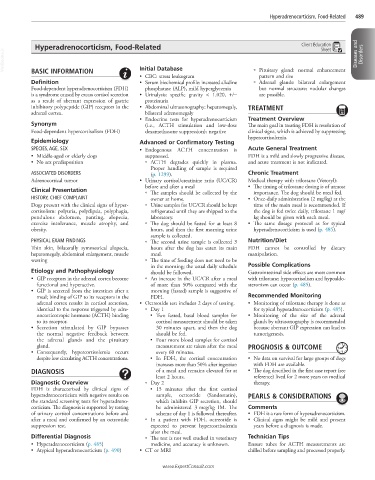Page 995 - Cote clinical veterinary advisor dogs and cats 4th
P. 995
Hyperadrenocorticism, Food-Related 489
Hyperadrenocorticism, Food-Related Client Education
Sheet
VetBooks.ir Initial Database Diseases and Disorders
BASIC INFORMATION
• CBC: stress leukogram ○ Pituitary gland: normal enhancement
pattern and size
Definition • Serum biochemical profile: increased alkaline ○ Adrenal glands: bilateral enlargement
Food-dependent hyperadrenocorticism (FDH) phosphatase (ALP), mild hyperglycemia but normal structure; nodular changes
is a syndrome caused by excess cortisol secretion • Urinalysis: specific gravity < 1.020, +/− are possible.
as a result of aberrant expression of gastric proteinuria
inhibitory polypeptide (GIP) receptors in the • Abdominal ultrasonography: hepatomegaly, TREATMENT
adrenal cortex. bilateral adrenomegaly
• Endocrine tests for hyperadrenocorticism Treatment Overview
Synonym (i.e., ACTH stimulation and low-dose The main goal in treating FDH is resolution of
Food-dependent hypercortisolism (FDH) dexamethasone suppression): negative clinical signs, which is achieved by suppressing
hypercortisolemia.
Epidemiology Advanced or Confirmatory Testing
SPECIES, AGE, SEX • Endogenous ACTH concentration is Acute General Treatment
• Middle-aged or elderly dogs suppressed. FDH is a mild and slowly progressive disease,
• No sex predisposition ○ ACTH degrades quickly in plasma. and acute treatment is not indicated.
Proper handling of sample is required
ASSOCIATED DISORDERS (p. 1299). Chronic Treatment
Adrenocortical tumor • Urinary cortisol/creatinine ratio (UC/CR) Medical therapy with trilostane (Vetoryl):
before and after a meal • The timing of trilostane dosing is of utmost
Clinical Presentation ○ The samples should be collected by the importance. The dog should be meal fed.
HISTORY, CHIEF COMPLAINT owner at home. • Once-daily administration (2 mg/kg) at the
Dogs present with the clinical signs of hyper- ○ Urine samples for UC/CR should be kept time of the main meal is recommended. If
cortisolism: polyuria, polydipsia, polyphagia, refrigerated until they are shipped to the the dog is fed twice daily, trilostane 1 mg/
pendulous abdomen, panting, alopecia, laboratory. kg should be given with each meal.
exercise intolerance, muscle atrophy, and ○ The dog should be fasted for at least 8 • The same dosage protocol as for typical
obesity. hours, and then the first morning urine hyperadrenocorticism is used (p. 485).
sample is collected.
PHYSICAL EXAM FINDINGS ○ The second urine sample is collected 3 Nutrition/Diet
Thin skin, bilaterally symmetrical alopecia, hours after the dog has eaten its main FDH cannot be controlled by dietary
hepatomegaly, abdominal enlargement, muscle meal. manipulation.
wasting ○ The time of feeding does not need to be
in the morning; the usual daily schedule Possible Complications
Etiology and Pathophysiology should be followed. Gastrointestinal side effects are most common
• GIP receptors in the adrenal cortex become ○ An increase in the UC/CR after a meal with trilostane; hypocortisolism and hypoaldo-
functional and hyperactive. of more than 50% compared with the steronism can occur (p. 485).
• GIP is secreted from the intestines after a morning (fasted) sample is suggestive of
meal; binding of GIP to its receptors in the FDH. Recommended Monitoring
adrenal cortex results in cortisol secretion, • Octreotide test includes 2 days of testing. • Monitoring of trilostane therapy is done as
identical to the response triggered by adre- ○ Day 1 for typical hyperadrenocorticism (p. 485).
nocorticotropic hormone (ACTH) binding ■ Two fasted, basal blood samples for • Monitoring of the size of the adrenal
to its receptor. cortisol measurement should be taken glands by ultrasonography is recommended
• Secretion stimulated by GIP bypasses 30 minutes apart, and then the dog because aberrant GIP expression can lead to
the normal negative feedback between should be fed. tumorigenesis.
the adrenal glands and the pituitary ■ Four more blood samples for cortisol
gland. measurement are taken after the meal PROGNOSIS & OUTCOME
• Consequently, hypercortisolemia occurs every 60 minutes.
despite low circulating ACTH concentrations. ■ In FDH, the cortisol concentration • No data on survival for large groups of dogs
increases more than 50% after ingestion with FDH are available.
DIAGNOSIS of a meal and remains elevated for at • The dog described in the first case report (see
least 2 hours. reference) lived for 2 more years on medical
Diagnostic Overview ○ Day 2 therapy.
FDH is characterized by clinical signs of ■ 15 minutes after the first cortisol
hyperadrenocorticism with negative results on sample, octreotide (Sandostatin), PEARLS & CONSIDERATIONS
the standard screening tests for hyperadreno- which inhibits GIP secretion, should
corticism. The diagnosis is supported by testing be administered 3 mcg/kg IM. The Comments
of urinary cortisol concentrations before and scheme of day 1 is followed thereafter. • FDH is a rare form of hyperadrenocorticism.
after a meal and confirmed by an octreotide ○ In a patient with FDH, octreotide is • Clinical signs might be mild and present
suppression test. expected to prevent hypercortisolemia years before a diagnosis is made.
after the meal.
Differential Diagnosis ○ The test is not well studied in veterinary Technician Tips
• Hyperadrenocorticism (p. 485) medicine, and accuracy is unknown. Ensure tubes for ACTH measurements are
• Atypical hyperadrenocorticism (p. 490) • CT or MRI chilled before sampling and processed properly.
www.ExpertConsult.com

